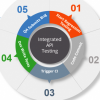Related Content
 |
How to Get Started Automating Your API Tests When designing a test automation strategy, an area that is often overlooked is automating API testing. API test scripts are faster and easier to write than other types of scripts and can be fairly simple tests. An added benefit is that API testing can be included in your continuous integration tools for quick feedback. |
|
 |
Make Time for Learning with Deliberate Practice As software professionals, we need to work continuously to improve our skills. But two common challenges are how to best work to improve, and how to find the time to learn when we’re busy. The answer is deliberate practice—practice with a clear goal and defined measures for success that pushes your usual boundaries. |
|
 |
The Key to Avoiding Procrastination If you have a task you've been putting off, dividing it into small chunks is a good idea. But the real key to overcoming procrastination is just getting started. Once you begin, you’ve built momentum and are likely to keep going, doing a little more until you’ve made good progress—and maybe even completed the job. |
|
 |
At What Point Will Automation Take Over Manual Testing? Better automation tools, the evolution of AI, AVM, visual testing—what’s going to make automation continue to spread through teams is the improvement of all the different solutions out there. And what should be encouraging to testers is the fact that just about every option requires smart, educated testers. |
|
 |
Elevate Code Quality by Integrating Testing and Development Pair programming generally involves two programmers working on a single change from start to finish. You can augment this pattern by adding a test specialist, so you can test-drive feature changes first and the tester can ask questions and guide test and code design. What you get is quality built in from the start. |
|
 |
The 5 Levels of Listening: Which Does Your Team Practice? The ways we listen—and not listen—are detailed in the Five Levels of Listening model, which goes from most distracted to most focused. Ideally, we’d all practice the fifth level: empathic listening, where we try to understand what matters to the person who is speaking, delaying our problem-solving and responsiveness. |
|
|
|
The Spectrum of Negotiation: Using the Right Skills for the Context Negotiation occurs on a spectrum, and different tactics apply in different situations. For instance, you’d treat a one-time transaction differently from an ongoing client relationship you want to nurture. Have you developed effective negotiating skills? Are you applying negotiating skills appropriate for the context? |
|
 |
Recognizing and Reversing a Culture of Blame A culture of blame is one in which people are reluctant to accept responsibility for things that go wrong. Finger-pointing becomes an automatic response. It's nearly impossible for one person to reverse a culture of blame alone, but it is possible to demonstrate on a small scale what appropriate behavior looks like. |






